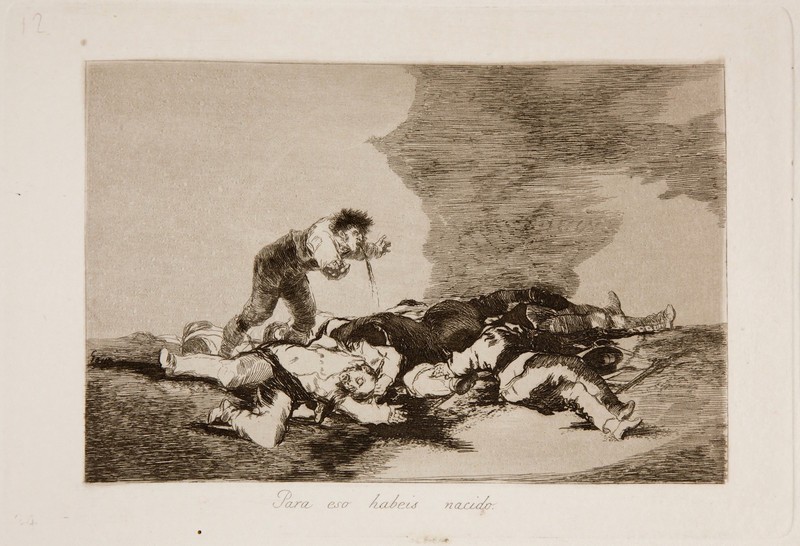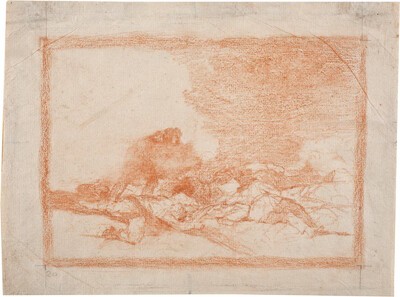- Cronología
- Ca. 1810 - 1812
- Dimensiones
- 163 x 237 mm
- Técnica y soporte
- Etching, lavis, drypoint and burin
- Reconocimiento de la autoría de Goya
- Undisputed work
- Ficha: realización/revisión
- 29 Nov 2010 / 24 May 2023
- Inventario
- 225
Goya (lower left-hand corner), 24 (lower left-hand corner of plate).
See Sad presentiments of what must come to pass.
There exists a state proof with drypoint in which the hat on the right-hand side has been made darker. In the next proof, Goya added the signature and some retouching with the burin on the vomiting man. In the following one, he added the lavis work across the entire plate.
The title was handwritten by Goya on the first and only print run that we know to have been made at the time, and which the painter gave to his friend Agustín Ceán Bermúdez. The title was engraved on to the copperplate at a later date, and no other modifications were made to the image for the first edition of the Disasters of War, which was printed by the Royal Academy of Fine Arts of San Fernando, Madrid, in 1863.
There is a preparatory drawing in the Prado Museum, Madrid.
In the middle of an area of open ground, Goya has etched a group of abandoned corpses. The postures of the discarded bodies and the inanimate expressions on their faces add to the horror of the image. Only one living person is shown, the man who is vomiting blood and who will also very soon form part of this mass of lifeless corpses. The scene takes place in an inhospitable, barren landscape; there are no trees or bushes, nor any homes in which to shelter.
The etching has been applied with precision and the hatching seems more elaborate in this print than in others in the Disasters of War series. The clouds in the sky have been rendered using very tightly packed horizontal lines, whilst the rest of the sky has been left as a large area of white.
Enrique Lafuente Ferrari, Valeriano Bozal and Jesusa Vega all relate this etching to no. 16, They avail themselves, nº 18, Bury them and keep quiet, no. 21, It will be the same, no. 22, All this and more, no. 23, The same elsewhere, no. 27, Charity, no. 48,A cruel shame!, nº 62, The deathbeds and no. 63, A collection of dead men, since all of these images feature depictions of piled up corpses.
The etching plate is conserved in the National Chalcography Museum (cat. 263)
-
GoyaMinistry of Foreing AffairsBurdeos1951organized by the Bordeaux City Hall, consultant editor Gilberte Martin-Méry. From May 16th to June 30th 1951cat. 6
-
De grafiek van GoyaRijksmuseum RijksprentenkabinetAmsterdam1970from November 13th 1970 to January 17th 1971cat. 61
-
Francisco de GoyaMuseo d'Arte ModernaLugano1996exhibition celebrated from September 22nd to November 17th.cat. 12
-
Francisco Goya. Sein leben im spiegel der graphik. Fuendetodos 1746-1828 Bordeaux. 1746-1996Galerie KornfeldBern1996from November 21st 1996 to January 1997cat. 100
-
Francisco Goya. Capricci, follie e disastri della guerraSan Donato Milanese2000Opere grafiche della Fondazione Antonio Mazzottacat. 92
-
Goya. Opera graficaPinacoteca del Castello di San GiorgioLegnano2006exhibition celebrated from December 16th 2006 to April 1st 2007p. 57
-
Goya et la modernitéPinacothèque de ParisParís2013from October 11st 2013 to March 16th 2014cat.51
-
Madrid2017
-
Goya, grabadorMadridBlass S.A.1918cat. 114
-
Goya engravings and lithographs, vol. I y II.OxfordBruno Cassirer1964cat. 132
-
Vie et ouvre de Francisco de GoyaParísOffice du livre1970cat. 1009
-
Goya. Arte e condizione umanaNaplesLiguori editore1990lam. 196
-
Catálogo de las estampas de Goya en la Biblioteca NacionalMadridMinisterio de Educación y Cultura, Biblioteca Nacional1996cat. 201
-
ParísPinacoteca de París2013p. 125
-
Goya. In the Norton Simon MuseumPasadenaNorton Simon Museum2016pp. 114-151
-
ZaragozaGobierno de Aragón y Fundación Bancaria Ibercaja2017p. 189

